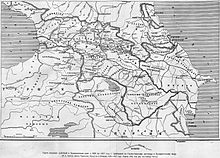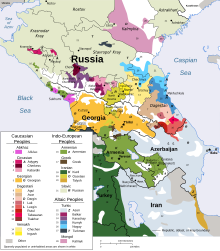South Ossetia
[29] According to Russian ambassador to Georgia Mikhail Tatishchev, at the beginning of the 17th century there was already a small group of Ossetians living near the headwaters of the Great Liakhvi.[42] In 1918, conflict began between the landless Ossetian peasants living in Shida Kartli (Interior Georgia), who were influenced by Bolshevism and demanded ownership of the lands they worked, and the Menshevik government backed ethnic Georgian aristocrats, who were legal owners.[14] On 11 December 1990, Zviad Gamsakhurdia's government declared the Ossetian election illegitimate and abolished South Ossetia's autonomous status altogether.[61] The 1991–1992 South Ossetia War was characterised by general disregard for international humanitarian law by uncontrollable militias, with both sides reporting atrocities.In March and April 1991, Soviet interior troops were reported actively disarming militias on both sides, and deterring the inter-ethnic violence.[62] On 22 December 1991, after a coup d'état, Gamsakhurdia and his supporters were besieged by the opposition, which was backed by the national guard, in several government buildings in Tbilisi."[78] Since 2004, tensions began to rise as the Georgian authorities strengthened their efforts to bring the region back under their rule, after it succeeded in Adjara.Georgia sent police to close down the Ergneti black market, which was one of the region's chief sources of revenue, selling foodstuffs and fuel smuggled from Russia.[85][83] The Georgian government protested against the allegedly increasing Russian economic and political presence in the region and against the uncontrolled military of the South Ossetian side.[93][94][95][96] According to U.S. senator Richard Lugar, the United States supported Georgia's call in 2006 for the withdrawal of Russian "peacekeepers" from the conflict zones."[98] Joe Biden (Chairman, U.S. Senate Foreign Relations Committee), Richard Lugar, and Mel Martínez sponsored a resolution in June 2008 accusing Russia of attempting to undermine Georgia's territorial integrity and called for replacing the Russian-comprised peacekeeping force operating under CIS mandate.[134][135] On 30 September 2009, the European Union–sponsored Independent International Fact-Finding Mission on the Conflict in Georgia stated that, while preceded by months of mutual provocations, "open hostilities began with a large-scale Georgian military operation against the town of Tskhinvali and the surrounding areas, launched in the night of 7 to 8 August 2008.[146] Ossetian leader Bibilov said in a lengthy interview that he planned to hold two referendums, one on annexation by Russia, and the second vote on joining North Ossetia,[147] for which he set the election proceedings in motion on April 7, 2022.It occupies the southern slopes of the Greater Caucasus mountain range and its foothills which are part of the Iberia Plain, a geographic plateau that is roughly in the center of South Ossetia.The penetration of humid air masses from the Black Sea to the west of South Ossetia is often blocked by the Likhi mountain range.The wettest periods of the year in South Ossetia generally occur during spring and autumn while the winter and summer months tend to be the driest.Elevation plays an important role in South Ossetia where climatic conditions above 1,500 m (4,921 ft) are considerably colder than in any lower-lying areas.Humidity is relatively low and rainfall across South Ossetia averages 500 to 800 mm (19.7 to 31.5 in) per year, but Alpine and highland regions have distinct microclimates.[citation needed] The Russian troops who patrol the borders of South Ossetia have reportedly been expanding the boundaries of the region through “encroaching occupation”, meaning they surreptitiously advance several feet at a time into Georgian-held territory.[167] This unilateral recognition by Russia was met by condemnation from Western Blocs, such as NATO, Organization for Security and Co-operation in Europe (OSCE) and the European Council due to the violation of Georgia's territorial integrity.[174] The European Union, Council of Europe, North Atlantic Treaty Organization (NATO) and most UN member countries do not recognise South Ossetia as an independent state.[181] In April 2007, Georgia created the Provisional Administrative Entity of South Ossetia,[182][183][184] staffed by ethnic Ossetian members of the separatist movement.[192] The Georgian Foreign Ministry described the signing of the treaty as "actual annexation" of the disputed region by Russia, and the United States and European Union said they would not recognise it.It stipulates that a special permit on entry into the breakaway regions can be issued if the trip there "serves Georgia's state interests; peaceful resolution of the conflict; de-occupation or humanitarian purposes.[209] The law says that the Russian Federation – the state which has carried out military occupation – is fully responsible for the violation of human rights in Abkhazia and South Ossetia.This close proximity and the intermixing of the two communities has made the Georgian–Ossetian conflict particularly dangerous, since any attempt to create an ethnically pure territory would involve population transfers on a large scale.Having successfully put an end to the de facto independence of the southwestern province of Ajaria in May 2004, he pledged to seek a similar solution in South Ossetia.On 25 January 2005, President Saakashvili presented a Georgian vision for resolving the South Ossetian conflict at the Parliamentary Assembly of the Council of Europe session in Strasbourg.After the OSCE resolution, the South Ossetian side surprised many with their own initiative reminiscent to the Georgian plan,[221] triggering optimism in Tbilisi.[249] By the end of 2021, the number of employed people was determined at 20,734 while 2,449 persons were registered as unemployed, on a total working age population of 34,308 (men 18–65, women 18–60).


















OssetiaAdministration of South OssetiaAlaniaNorth Ossetia–AlaniaOssetianRussian Coat of armsNational Anthem of the Republic of South OssetiaGeorgiaPartially recognised stateTskhinvaliEthnic groupsOssetiansGeorgiansRussiansArmeniansGovernmentsemi-presidential republicPresidentAlan GagloevPrime MinisterKonstantin DzhussoevParliamentPopulationRussian rubleDrives onCalling codepartially recognisedlandlocked countrySouth CaucasusUnited NationsRussiaVenezuelaNicaraguaGeorgian governmentsovereign territoryGeorgian–Ossetian conflictGeorgia–Russia relationsSouth Ossetian Autonomous OblastShida Kartlideclared independenceGeorgian Soviet Socialist Republic1991–1992 South Ossetia WarfrozenRusso-Georgian Warinternational communityoccupied by the Russian militarytheir intention of joining the Russian FederationJ. H. ColtonCaucasusIranianMongolKingdom of GeorgiaZakagoriOssetian languageKabardianNorth CaucasusKingdom of KartliGreat LiakhviKartliJohann Anton GüldenstädtMajor Caucasus RidgeJejoraGreater LiakhviLittle LiakhviAragviKingdom of Kartli-KakhetiRussian EmpirePaul RennenkampffGeorgia was part of the Russian EmpireTrialetiBorjomiBakurianiKakhetiRussian revolutionDemocratic Republic of Georgiaconflict beganBolshevismMenshevik governmentTiflisSoviet RussiaRed Army invasion of GeorgiaTranscaucasianKavbiuroCommunist Party of the Soviet UnionBolsheviksBolshevikGori uezdDusheti uezdTiflis GovernorateRacha uezdKutaisi GovernorateNorth Ossetian Autonomous OblastGeorgian1918–1920 eventsMongol invasionsautonomous republicSupreme SovietSoviet UnionZviad GamsakhurdiaMikhail GorbachevPrigorodnyi DistrictIngushStalinearthquakecoup d'étatTbilisiGeorgian military councilJaba IoselianiTengiz KitovaniTengiz SiguaEduard Shevardnadzeindependence referendumGeorgian Civil WarSochi ceasefire agreementAkhalgoriJoined Peacekeeping forceOrganization for Security and Co-operation in EuropeRose RevolutionMikheil SaakashviliAdjaraRoki Tunnelpeacekeeping forceRichard LugarPeter SemnebyGeorgia spy row